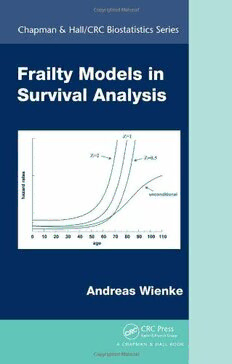Download Frailty Models in Survival Analysis (Chapman & Hall CRC Biostatistics Series) PDF Free - Full Version
Download Frailty Models in Survival Analysis (Chapman & Hall CRC Biostatistics Series) by Andreas Wienke in PDF format completely FREE. No registration required, no payment needed. Get instant access to this valuable resource on PDFdrive.to!
About Frailty Models in Survival Analysis (Chapman & Hall CRC Biostatistics Series)
The concept of frailty offers a convenient way to introduce unobserved heterogeneity and associations into models for survival data. In its simplest form, frailty is an unobserved random proportionality factor that modifies the hazard function of an individual or a group of related individuals. Frailty Models in Survival Analysis presents a comprehensive overview of the fundamental approaches in the area of frailty models. The book extensively explores how univariate frailty models can represent unobserved heterogeneity. It also emphasizes correlated frailty models as extensions of univariate and shared frailty models. The author analyzes similarities and differences between frailty and copula models; discusses problems related to frailty models, such as tests for homogeneity; and describes parametric and semiparametric models using both frequentist and Bayesian approaches. He also shows how to apply the models to real data using the statistical packages of R, SAS, and Stata. The appendix provides the technical mathematical results used throughout. Written in nontechnical terms accessible to nonspecialists, this book explains the basic ideas in frailty modeling and statistical techniques, with a focus on real-world data application and interpretation of the results. By applying several models to the same data, it allows for the comparison of their advantages and limitations under varying model assumptions. The book also employs simulations to analyze the finite sample size performance of the models.
Detailed Information
| Author: | Andreas Wienke |
|---|---|
| Publication Year: | 2010 |
| ISBN: | 9781420073881 |
| Pages: | 320 |
| Language: | English |
| File Size: | 1.954 |
| Format: | |
| Price: | FREE |
Safe & Secure Download - No registration required
Why Choose PDFdrive for Your Free Frailty Models in Survival Analysis (Chapman & Hall CRC Biostatistics Series) Download?
- 100% Free: No hidden fees or subscriptions required for one book every day.
- No Registration: Immediate access is available without creating accounts for one book every day.
- Safe and Secure: Clean downloads without malware or viruses
- Multiple Formats: PDF, MOBI, Mpub,... optimized for all devices
- Educational Resource: Supporting knowledge sharing and learning
Frequently Asked Questions
Is it really free to download Frailty Models in Survival Analysis (Chapman & Hall CRC Biostatistics Series) PDF?
Yes, on https://PDFdrive.to you can download Frailty Models in Survival Analysis (Chapman & Hall CRC Biostatistics Series) by Andreas Wienke completely free. We don't require any payment, subscription, or registration to access this PDF file. For 3 books every day.
How can I read Frailty Models in Survival Analysis (Chapman & Hall CRC Biostatistics Series) on my mobile device?
After downloading Frailty Models in Survival Analysis (Chapman & Hall CRC Biostatistics Series) PDF, you can open it with any PDF reader app on your phone or tablet. We recommend using Adobe Acrobat Reader, Apple Books, or Google Play Books for the best reading experience.
Is this the full version of Frailty Models in Survival Analysis (Chapman & Hall CRC Biostatistics Series)?
Yes, this is the complete PDF version of Frailty Models in Survival Analysis (Chapman & Hall CRC Biostatistics Series) by Andreas Wienke. You will be able to read the entire content as in the printed version without missing any pages.
Is it legal to download Frailty Models in Survival Analysis (Chapman & Hall CRC Biostatistics Series) PDF for free?
https://PDFdrive.to provides links to free educational resources available online. We do not store any files on our servers. Please be aware of copyright laws in your country before downloading.
The materials shared are intended for research, educational, and personal use in accordance with fair use principles.

